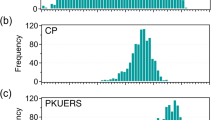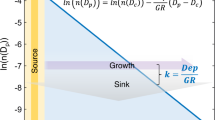Abstract
Atmospheric black carbon makes an important but poorly quantified contribution to the warming of the global atmosphere. Laboratory and modelling studies have shown that the addition of non-black-carbon materials to black-carbon particles may enhance the particles’ light absorption by 50 to 60% by refracting and reflecting light. Real-world experimental evidence for this ‘lensing’ effect is scant and conflicting, showing that absorption enhancements can be less than 5% or as large as 140%. Here we present simultaneous quantifications of the composition and optical properties of individual atmospheric black-carbon particles. We show that particles with a mass ratio of non-black carbon to black carbon of less than 1.5, which is typical of fresh traffic sources, are best represented as having no absorption enhancement. In contrast, black-carbon particles with a ratio greater than 3, which is typical of biomass-burning emissions, are best described assuming optical lensing leading to an absorption enhancement. We introduce a generalized hybrid model approach for estimating scattering and absorption enhancements based on laboratory and atmospheric observations. We conclude that the occurrence of the absorption enhancement of black-carbon particles is determined by the particles’ mass ratio of non-black carbon to black carbon.
This is a preview of subscription content, access via your institution
Access options
Access Nature and 54 other Nature Portfolio journals
Get Nature+, our best-value online-access subscription
$29.99 / 30 days
cancel any time
Subscribe to this journal
Receive 12 print issues and online access
$259.00 per year
only $21.58 per issue
Buy this article
- Purchase on Springer Link
- Instant access to full article PDF
Prices may be subject to local taxes which are calculated during checkout



Similar content being viewed by others
References
Bond, T. C. et al. Bounding the role of black carbon in the climate system: a scientific assessment. J. Geophys. Res. 118, 5380–5552 (2013).
Bond, T. C., Habib, G. & Bergstrom, R. W. Limitations in the enhancement of visible light absorption due to mixing state. J. Geophys. Res. 111, D20211 (2006).
Fuller, K. A., Malm, W. C. & Kreidenweis, S. M. Effects of mixing on extinction by carbonaceous particles. J. Geophys. Res. 104, 15941–15954 (1999).
Jacobson, M. Z. Strong radiative heating due to the mixing state of black carbon in atmospheric aerosols. Nature 409, 695–697 (2001).
Adachi, K., Chung, S. H. & Buseck, P. R. Shapes of soot aerosol particles and implications for their effects on climate. J. Geophys. Res. 115, D15206 (2010).
China, S., Mazzoleni, C., Gorkowski, K., Aiken, A. C. & Dubey, M. K. Morphology and mixing state of individual freshly emitted wildfire carbonaceous particles. Nat. Commun. 4, 2122 (2013).
Liu, D. et al. Single particle characterization of black carbon aerosols at a tropospheric alpine site in Switzerland. Atmos. Chem. Phys. 10, 7389–7407 (2010).
Sedlacek, A. J., Lewis, E. R., Kleinman, L., Xu, J. & Zhang, Q. Determination of and evidence for non-core-shell structure of particles containing black carbon using the Single-Particle Soot Photometer (SP2). Geophys. Res. Lett. 39, L06802 (2012).
Moteki, N., Kondo, Y. & Adachi, K. Identification by single-particle soot photometer of black carbon particles attached to other particles: laboratory experiments and ground observations in Tokyo. J. Geophys. Res. 119, 1031–1043 (2014).
Ristimäki, J., Vaaraslahti, K., Lappi, M. & Keskinen, J. Hydrocarbon condensation in heavy-duty diesel exhaust. Environ. Sci. Technol. 41, 6397–6402 (2007).
Liu, D. et al. The effect of complex black carbon microphysics on the determination of the optical properties of brown carbon. Geophys. Res. Lett. 42, 613–619 (2015).
Moteki, N., Kondo, Y. & Nakamura, S.-I. Method to measure refractive indices of small nonspherical particles: application to black carbon particles. J. Aerosol Sci. 41, 513–521 (2010).
Taylor, J. W. et al. Assessment of the sensitivity of core/shell parameters derived using the single-particle soot photometer to density and refractive index. Atmos. Meas. Tech. 8, 1701–1718 (2015).
Bond, T. C. & Bergstrom, R. W. Light absorption by carbonaceous particles: an investigative review. Aerosol Sci. Tech. 40, 27–67 (2006).
Cappa, C. D. et al. Radiative absorption enhancements due to the mixing state of atmospheric black carbon. Science 337, 1078–1081 (2012).
Liu, S. et al. Enhanced light absorption by mixed source black and brown carbon particles in UK winter. Nat. Commun. 6, 8435 (2015).
Liu, D. et al. Size distribution, mixing state and source apportionment of black carbon aerosol in London during wintertime. Atmos. Chem. Phys. 14, 10061–10084 (2014).
McMeeking, G. et al. Impacts of nonrefractory material on light absorption by aerosols emitted from biomass burning. J. Geophys. Res. 119, 12272–12286 (2014).
Peng, J. et al. Markedly enhanced absorption and direct radiative forcing of black carbon under polluted urban environments. Proc. Natl Acad. Sci. USA 113, 4266–4271 (2016).
Mann, G. et al. Description and evaluation of GLOMAP-mode: a modal global aerosol microphysics model for the UKCA composition-climate model. Geosci. Model Dev. 3, 519–551 (2010).
Liu, D. et al. Carbonaceous aerosols contributed by traffic and solid fuel burning at a polluted rural site in Northwestern England. Atmos. Chem. Phys. 11, 1603–1619 (2011).
Liu, D. et al. Size distribution, mixing state and source apportionment of black carbon aerosol in London during wintertime. Atmos. Chem. Phys. 14, 10061–10084 (2014).
Canonaco, F., Crippa, M., Slowik, J., Baltensperger, U. & Prévôt, A. SoFi, an IGOR-based interface for the efficient use of the generalized multilinear engine (ME-2) for the source apportionment: ME-2 application to aerosol mass spectrometer data. Atmos. Meas. Tech. 6, 3649–3661 (2013).
Crippa, M. et al. Wintertime aerosol chemical composition and source apportionment of the organic fraction in the metropolitan area of Paris. Atmos. Chem. Phys. 13, 961–981 (2013).
Olfert, J. & Collings, N. New method for particle mass classification—the Couette centrifugal particle mass analyzer. J. Aerosol Sci. 36, 1338–1352 (2005).
Moteki, N. & Kondo, Y. Effects of mixing state on black carbon measurements by laser-induced incandescence. Aerosol Sci. Tech. 41, 398–417 (2007).
Bond, T. C. & Bergstrom, R. W. Light absorption by carbonaceous particles: an investigative review. Aerosol. Sci. Tech. 40, 27–67 (2006).
Adler, G., Riziq, A. A., Erlick, C. & Rudich, Y. Effect of intrinsic organic carbon on the optical properties of fresh diesel soot. Proc. Natl Acad. Sci. USA 107, 6699–6704 (2010).
Gao, R. et al. A novel method for estimating light-scattering properties of soot aerosols using a modified single-particle soot photometer. Aerosol Sci. Tech. 41, 125–135 (2007).
Lack, D. A. et al. Absorption enhancement of coated absorbing aerosols: validation of the photo-acoustic technique for measuring the enhancement. Aerosol Sci. Tech. 43, 1006–1012 (2009).
Liu, D. et al. The effect of complex black carbon microphysics on the determination of the optical properties of brown carbon. Geophys. Res. Lett. 42, 613–619 (2015).
Park, K., Cao, F., Kittelson, D. B. & McMurry, P. H. Relationship between particle mass and mobility for diesel exhaust particles. Environ. Sci. Technol. 37, 577–583 (2003).
Cross, E. S. et al. Laboratory and ambient particle density determinations using light scattering in conjunction with aerosol mass spectrometry. Aerosol Sci. Tech. 41, 343–359 (2007).
Young, D. et al. Investigating the annual behaviour of submicron secondary inorganic and organic aerosols in London. Atmos. Chem. Phys. 15, 6351–6366 (2015).
Nakao, S. et al. Density and elemental ratios of secondary organic aerosol: application of a density prediction method. Atmos. Environ. 68, 273–277 (2013).
Abdul-Khalek, I. S. & Kittelson, D. B. Real Time Measurement of Volatile and Solid Exhaust Particles Using a Catalytic Stripper Report No. 0148-7191 (SAE Technical Paper, 1995).
Mann, G. et al. Description and evaluation of GLOMAP-mode: a modal global aerosol microphysics model for the UKCA composition-climate model. Geosci. Model Dev. 3, 519–551 (2010).
Mann, G. et al. Intercomparison of modal and sectional aerosol microphysics representations within the same 3-D global chemical transport model. Atmos. Chem. Phys. 12, 4449–4476 (2012).
Peña, O. & Pal, U. Scattering of electromagnetic radiation by a multilayered sphere. Comput. Phys. Comm. 180, 2348–2354 (2009).
Acknowledgements
This work was supported through the UK Natural Environment Research Council (NERC) through the Com-Part (grant ref: NE/K014838/1), ClearfLo (grant ref: NE/H003150/1), MC4 (grant ref: NE/H008136/1), SAMBBA (grant refs: NE/J010073/1; NE/J009822/1), GASSP (grant refs: NE/J023515/1; NE/J024252/1) projects and a PhD studentships for S.H. (grant ref: NE/L002469/1) and J.W.T. The studentship of E.R.-V. was supported by the National Council of Science and Technology—Mexico (CONACyT; registry no: 217687). The Manchester chamber has received funding from the European Union’s Framework 7 EUROCHAMP2 Network and currently from the Horizon 2020 research and innovation programme through the EUROCHAMP-2020 Infrastructure Activity under grant agreement no. 730997.
Author information
Authors and Affiliations
Contributions
J.D.A., D.L., M.R.A. and G.M. designed the research; J.D.A., D.L., J.W., M.R.A., E.R.-V., S.K., J.W.T., P.I.W., Y.-C.T., M.J.F. and S.H. performed experiments; D.L., E.R.-V., J.W.T. and W.T.M. performed data analysis; D.V.S and C.L.R. performed model simulation; D.L., J.D.A., H.C., G.M. and E.R.-V. wrote the paper.
Corresponding authors
Ethics declarations
Competing interests
The authors declare no competing financial interests.
Supplementary information
Supplementary Information
Supplementary Information (PDF 2055 kb)
Rights and permissions
About this article
Cite this article
Liu, D., Whitehead, J., Alfarra, M. et al. Black-carbon absorption enhancement in the atmosphere determined by particle mixing state. Nature Geosci 10, 184–188 (2017). https://doi.org/10.1038/ngeo2901
Received:
Accepted:
Published:
Issue Date:
DOI: https://doi.org/10.1038/ngeo2901
This article is cited by
-
Significant contribution of fractal morphology to aerosol light absorption in polluted environments dominated by black carbon (BC)
npj Climate and Atmospheric Science (2024)
-
Microphysical properties of atmospheric soot and organic particles: measurements, modeling, and impacts
npj Climate and Atmospheric Science (2024)
-
Overestimation of black carbon light absorption due to mixing state heterogeneity
npj Climate and Atmospheric Science (2024)
-
One-year observation of the mixing states of oxygenated organics-containing single particles in Guangzhou, China
Frontiers of Environmental Science & Engineering (2024)
-
Climate-relevant properties of black carbon aerosols revealed by in situ measurements: a review
Progress in Earth and Planetary Science (2023)



